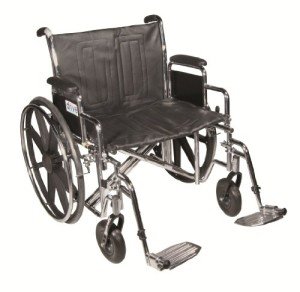Bariatric Wheelchair Seat Width
Seat Width
Having the proper seat width is essential to wheelchair users who invest longer durations in their chairs. Too narrow a seat will cause pressure on the hips and thighs which might result in sores or pressure points. Having too wide a seat can also make it tough for the user to reach the hand rims to propel themselves or maneuver in little spaces.

To measure the proper seat width an individual would sit on a chair normally and have their measurement taken throughout their lap at the widest point which is normally their hips. A wheelchair determining tape can be utilized to measure this, however a lawn stick is preferred as it avoids people from wrapping the tape around their hips which would provide an inaccurate result.
The standard wheelchair seat width is 16" (narrow grownup), 18" (basic adult), and 20" (broad grownup). For bariatric patients, a 24" seat is offered. This durable additional large bariatric wheelchair from Medline includes swing-away footrests, a carbon steel frame with rust- and chip-resistant chrome plating, and easy-to-clean vinyl upholstery. It has a weight capacity of 500 pounds.
Seat Depth
Traditionally, the seat depth of a bariatric wheelchair was included 2" to the measurement taken at the user's largest point (generally their hips). This was indicated to accommodate additional layers of clothes that may be worn throughout cold weather. Nevertheless, this practice is becoming less typical as wheelchair users are able to invest more time indoors and are not wearing long coats. This makes the seat depth of a chair lesser when picking a bariatric wheelchair. Nevertheless, it is still crucial to choose an option that offers adequate assistance for bigger users.
The Medline folding additional wide bariatric manual wheelchair includes a comfortable 24" seat width and a durable slide tube silver vein frame. It also has an adjustable axle and tool-free elevating legrests.
Seat Height
When it concerns identifying the right wheelchair seat width you should always determine from the user's largest point which is normally their hips. You will also need to think about whether the user is going to be wearing a winter season coat as this may add 2" to the width needed.
When a wheelchair remains in usage it must only be operated on level surface areas with the wheel locks fully engaged. This is to prevent the chair from being able to move inclines that are 10 degrees or greater. It is also essential to keep in mind that any activity that may shift the center of gravity in the chair need to be done with care. This includes reaching for products that need the person to lean out of their seat or attempting to stand from it.
Whenever you have the chair in use it is recommended that you frequently check it for damage and lube any locations that are deemed needed. For example, the casters need to be lubed by getting rid of the caster fork and utilizing a multi-purpose grease to use to the caster stem bearings. Also, the foot plates can be changed by loosening the bolt and after that moving them to the wanted position. bariatric transport wheelchair 400 lb capacity enables the feet to sit easily on the footplate and prevents any pressure points from forming. This can be extremely uneasy for the user and if left unattended, can result in press sores.
Weight Capacity
Bariatric wheelchairs are designed to support more weight than standard wheelchairs. This makes them tougher and better geared up to deal with falls. They are also generally bigger and broader, making them less maneuverable in tight spaces than basic wheelchairs. They need lorries with unique ramps and lifts to load them, along with chauffeurs who understand how to best transport them from one location to the next.
When picking a wheelchair, consider its weight capacity as it will be the primary determining consider whether it will accommodate your traveler's requirements. The weight capacity of the chair is frequently noted as a static load, implying that it indicates the amount of weight the chair can easily hold while standing still. However, some makers likewise note an active load that is based on a drop test and can simulate the result of somebody taking a seat in the chair. This may be a more trusted measurement of the weight limit, depending upon your requirements.
If you plan to carry out activities that move your center of gravity in the seat (such as reaching for items), make sure to have front casters pointed in a forward direction and wheel locks engaged so the chair will not topple. Likewise, check that casters are lubricated frequently to prevent extreme wear and abrasions. The lubrication procedure involves getting rid of the fork, separating the caster from the wheel, and greasing the caster stem bearings with high-quality multi-purpose grease.
